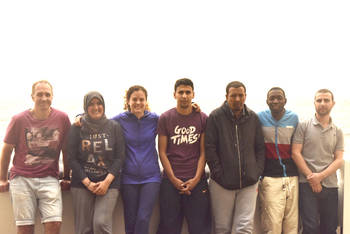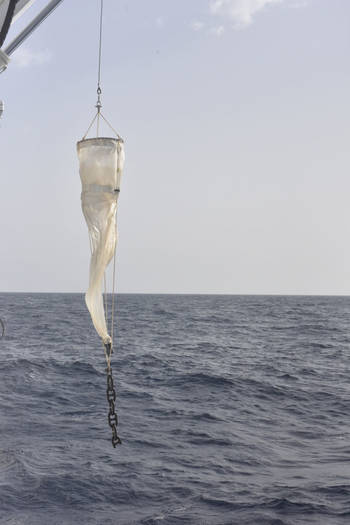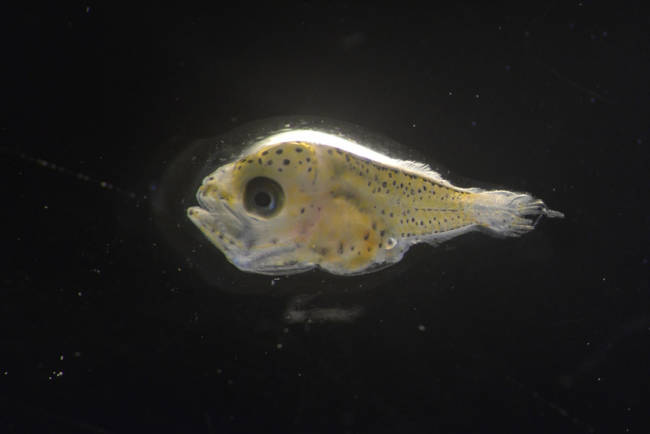Everything you ever wanted to know about plankton and microplastics sampling
Hinde Abdelouahab and Alba Jurado-Ruzafa are two of the international scientists aboard this third leg of the Northwestern Africa survey voyage, and they contributed this blog post to illustrate to us the daily work undertaken by the “Plankton Team” aboard the Nansen.
During our survey with the new research vessel Dr. Fridtjof Nansen, we are sampling plankton and microplastics. Said simply, “plankton” is a collective term for very small organisms (both plants and animals) whose “large scale movement” depend mainly on the drift of surrounding water-masses rather than on their own motion. The plankton represents a crucial food source for many (larger) marine species.
We sample along predetermined transects, each comprising three stations (coastal, intermediate and a deeper station). Our objectives are to collect data on plankton species composition, abundances and biomasses, including fish-larvae and eggs, as well as microplastics, along the Northwest African Coast. Our cruise started in Las Palmas and will end in Dakar, covering the coastal area from Cape Juby o(Morocco) to Saint-Louis (Senegal). Six participants from Morocco, Mauritania, Gambia and Spain, as well as a Norwegian planktonscientist, form the plankton team on this cruise.
More about Plankton
Phytoplankton (microscopic plantorganisms) are collected from the upper 30 meters using a net with mesh-size 10µm, as illustrated in the accompanying photo, and will be analyzed taxonomically on shore after the cruise.
Zooplankton (mostly millimeter-sized animals) are sampled using a WP2-net with mesh-size 180 µm. Half of each sample is preserved for subsequent taxonomical analysis, in order to determine abundances and distributions. The other half is dedicated to determination of biomasses within different size-groups.
Ichthyoplankton (fish-eggs and larvae) are collected using a Hydrobios Multinet with a mesh-size of 405 µm. The net is towed obliquely from the bottom (or a maximum of 100m) to the surface. Samples are preserved to enable later taxonomical analyses. However, already during the cruise we have begun the sorting and are taking pictures of fish larvae under stereomicroscope.
Microplastics
The occurrence of microplastics in the marine environment and the potential consequences of such in the food web, has raised strong concerns worldwide during the latest years.
For this reason, sampling and description of microplastic abundances and distributions has now been included in the objectives of the EAF Nansen Science Programme. To our knowledge, we are the first to collect surface microplastic samples in this area.
For this purpose, we apply the Manta-trawl with a 335 µm mesh-size, towed at 1.5 m/s for 15 minutes in the surface layer.
Later, in the ship laboratory, we sort the microplastic particles from the samples under the stereomicroscope. These are measured, described, photographed, and will be studied in more detail after the cruise.
The remaining part of the samples (mainly biological material) is preserved for studies of the surface-related organisms.
In the samples we have collected so far, a large variability in the amounts and types of these particles have been observed.
Preliminary results suggest that among the 15 samples already processed, 12 contained fewer than 25 microplastic particles, one had between 25 and 50 particles, one contained between 50 and 100, and only one sample held more than 100 microplastics.

- The Manta-trawl which is used to sample the sea-surface for microplastics.

- An unsorted Manta-trawl sample showing neuston and microplastics.
Whether these amounts should be considered high or low, will require a comparison with the results from other studies.
This gives you an idea of the work carried out daily – in rotating 24-hour shifts – by our international Plankton Team.
We welcome any questions you may have, simply submit them via the comment box below.
Thanks for joining alongside us on our plankton and microplastics research. Until next time!

- Sorted particles of microplastic









